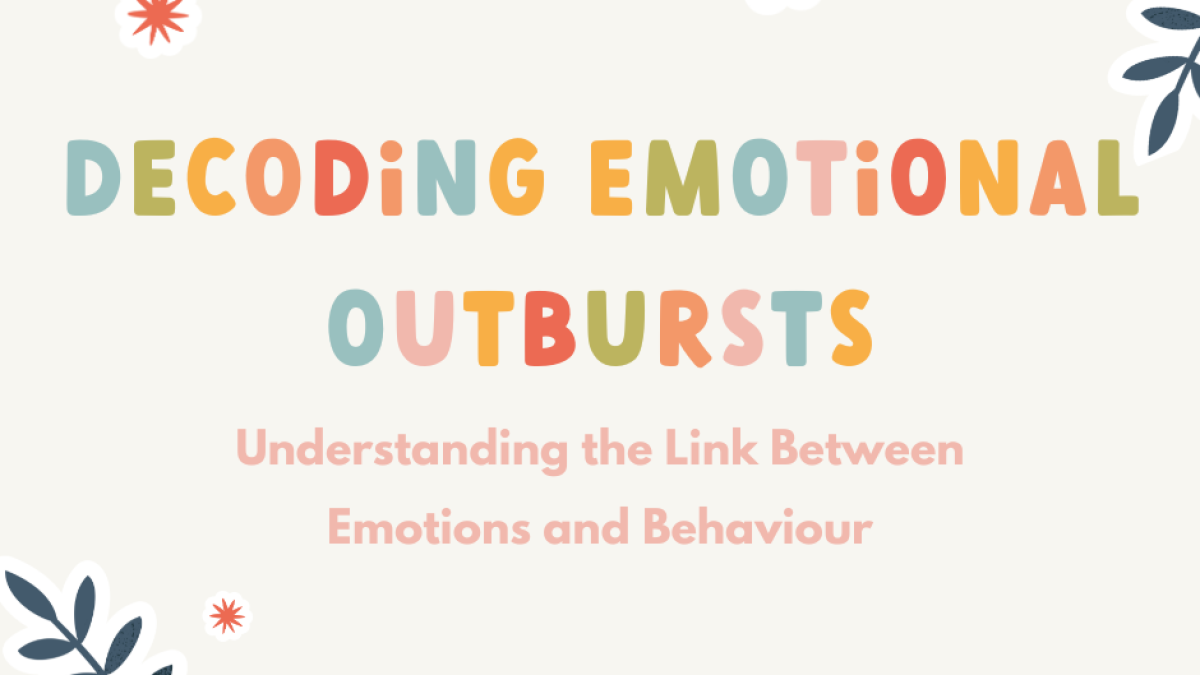Decoding Emotional Outbursts: Understanding the Link Between Emotions and Behaviour

Discover how emotions drive behaviour in children, especially late talkers, and learn strategies to support their emotional and language development.
Decoding Emotional Outbursts: Understanding the Link Between Emotions and Behaviour
When a child is having an emotional outburst, it can be challenging for parents to understand the underlying cause. For children who are late talkers, these outbursts can be particularly confusing, as they may struggle to express what they are feeling. Often, the inability to communicate emotions leads to frustration, which in turn can result in challenging behaviours.
Understanding the connection between emotions and behaviour is key to supporting your child’s emotional and language development. This blog will explore how children’s emotions directly influence their behaviour, and how you can identify the root of their emotional distress to help them manage their feelings more effectively.
The Link Between Emotions and Behaviour
Emotions play a powerful role in driving behaviour, especially in young children who are still learning to understand and regulate their feelings. When children experience strong emotions—such as frustration, sadness, anger, or even excitement—they may act out in ways that seem difficult to manage. Outbursts, tantrums, or withdrawal can all be signs that a child is struggling with an overwhelming emotion they don’t yet know how to express.
For late talkers, these situations can be particularly intense because their ability to communicate verbally is still developing. Without the words to convey how they feel, children may use their behaviour as a form of emotional communication. A tantrum, for example, might be a sign that a child is feeling misunderstood, overwhelmed, or anxious. By recognising these behaviours as attempts to communicate emotions, parents and caregivers can begin to decode the emotional message behind the behaviour.
Identifying the Root Emotions
So, how can you begin to understand the emotions driving your child’s behaviour? Here are a few strategies:
- Observe the Behaviour Closely
Look for patterns in your child’s behaviour that might give you clues about their emotional state. Does the child become more upset in certain situations? Are there specific triggers, such as transitions, noise, or unfamiliar people, that seem to result in emotional outbursts? Recognising patterns can help you identify the emotions underlying the behaviour. - Tune Into Non-Verbal Cues
While late talkers may struggle to express emotions with words, they often communicate their feelings in other ways. Pay attention to your child’s body language, facial expressions, and tone of voice. Even if they cannot articulate their feelings verbally, these non-verbal cues can provide valuable insight into what they are experiencing emotionally. - Consider the Child’s Developmental Stage
Emotional regulation is a skill that develops over time. A child who is still learning how to manage strong emotions may need more guidance and support. Be mindful of where your child is in their emotional development and offer comfort and reassurance when they are struggling to control their feelings.
Helping Children Manage Their Emotions
Once you have identified the root emotions behind your child’s behaviour, the next step is to help them manage these feelings in a healthy way. Here are some strategies to try:
- Name the Emotion
Even if your child isn’t yet able to name their feelings, you can model this for them. For example, if your child is upset because they can’t have a toy, you might say, "I can see you’re feeling frustrated right now." Naming the emotion helps your child begin to make the connection between what they are feeling and how to express it. - Offer Choices
Providing your child with choices can help them feel more in control and reduce feelings of frustration. For instance, if your child is upset about not being able to play outside, offer them a choice of indoor activities they can engage in instead. This not only diffuses the situation but also gives your child the opportunity to communicate their preference. - Teach Calming Techniques
Encourage your child to use simple calming strategies when they are feeling overwhelmed. This could be as simple as taking deep breaths, using a favourite object for comfort, or engaging in a quiet activity like drawing. By practising these techniques, your child can learn to self-regulate their emotions. - Encourage Emotional Expression Through Play
Playtime is a natural way for children to express their emotions. Encouraging activities that allow your child to act out different scenarios, such as role-playing with dolls or action figures, can provide them with an opportunity to process and express their feelings in a safe and creative way.
Supporting Emotional and Language Development Together
The link between emotions and behaviour is particularly significant for late talkers. As your child works to develop their verbal communication skills, they may rely on behaviour to express what they cannot yet say with words. By focusing on emotional communication—both verbal and non-verbal—you can support your child’s language development while also helping them manage their emotions.
Remember, emotional communication is a two-way process. By acknowledging and responding to your child’s emotions, you are not only helping them feel understood but also providing them with the tools they need to express their feelings in healthy and constructive ways. This foundation of emotional understanding will not only foster better behaviour but also support your child’s overall development, including their ability to communicate effectively in the future.
In conclusion, by tuning into your child’s emotions, identifying the causes behind their behaviour, and offering strategies to manage those feelings, you can create an environment that promotes both emotional well-being and language growth.
Want to understand behaviour further?
Try these 5 everyday moments to boost your child's communication.
 Joanne Jones
Joanne Jones 